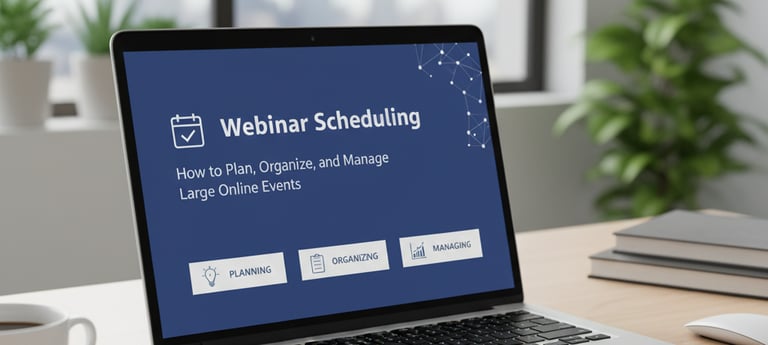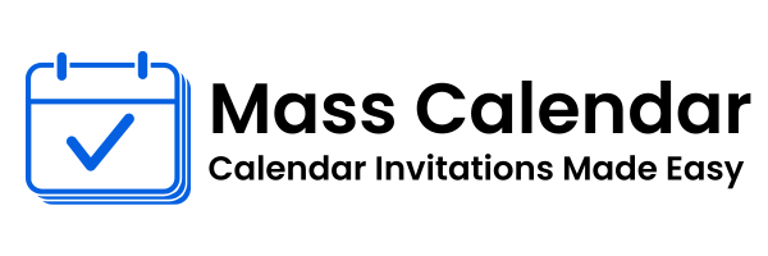Webinar Scheduling How to Plan, Organize, and Manage Large Online Events
Webinars have become a core part of digital engagement. From business presentations to online workshops, they bring people together virtually for learning and collaboration. However, managing large-scale webinars often means handling hundreds of attendees, multiple sessions, and complex schedules all of which can be overwhelming.
BLOG
11/13/20253 min read


Webinars have become a core part of digital engagement. From business presentations to online workshops, they bring people together virtually for learning and collaboration. However, managing large-scale webinars often means handling hundreds of attendees, multiple sessions, and complex schedules all of which can be overwhelming.
That’s where an effective webinar scheduling tool and structured event planning approach make all the difference. Let’s look at how you can schedule and manage webinars smoothly without missing any details.
The Importance of Webinar Scheduling
Scheduling is one of the most critical steps in webinar management. Poorly planned timing can lead to low attendance and confusion among participants. On the other hand, a clear and well-organized calendar structure ensures your event runs seamlessly.
Proper scheduling allows you to:
Avoid time clashes with other major events.
Give attendees enough time to prepare.
Send reminders and confirmations on time.
Keep all event details consistent across teams and participants.
How to Schedule a Webinar Effectively
Here’s a step-by-step process to organize your next webinar successfully:
Define the Purpose and Audience:
Determine the goal of your webinar education, marketing, or training and identify who should attend.Choose the Right Date and Time:
Research your audience’s availability. Avoid weekends or conflicting industry events.Create a Central Calendar Event:
Add all key details like the title, agenda, presenter name, and joining link.Invite Participants:
Use a bulk calendar approach to reach all your invitees at once. This saves hours of manual work.Send Reminders:
Schedule follow-up reminders one day and one hour before the session.
This method ensures your event stays organized and participants stay informed.
Handling Bulk Invitations for Webinars
If you’re hosting multiple sessions or large-scale webinars, manually sending invites is impractical. Instead, send bulk calendar invites to distribute all event details efficiently.
Here’s how:
Import your attendee list.
Create an event with all details.
Add all participants as attendees.
Send the invite once.
That’s it your audience will receive calendar notifications automatically. This process helps manage send mass meeting invites across time zones and departments effectively.
Managing Multiple Webinar Sessions
Many webinars consist of breakout sessions, Q&A discussions, or parallel events. Managing these requires careful organization of multiple calendar invites so attendees know which sessions to join.
Tips for smooth management:
Label sessions clearly with distinct titles.
Assign session-specific time slots.
Avoid overlapping schedules.
Provide all join links and details in advance.
Using mass calendar invites keeps everyone on the same page while minimizing confusion.
Communication and Follow-Up
Your communication shouldn’t stop once invites are sent. To ensure engagement:
Send confirmations to those who accept the invite.
Share reminders close to the webinar date.
Send follow-up messages or recordings after the event ends.
These steps build better relationships with your audience and help improve attendance rates for future events.
Common Mistakes to Avoid
When dealing with bulk or mass invitations, watch out for:
Incomplete Details: Always double-check time, link, and date before sending.
Ignoring Time Zones: Schedule according to participants’ regions if your audience is global.
Overloading Participants: Avoid sending multiple reminders in a short period.
The Role of Consistency in Webinar Scheduling
Consistency builds trust. Keeping a structured format for all your sessions makes it easier for your attendees to follow along. Always include:
A descriptive title.
The exact time and duration.
The speaker’s name and topic.
A clear call-to-action or link to join.
Such practices ensure that every bulk meeting invite or webinar session invitation feels professional and organized.
Conclusion
Webinar scheduling is more than just setting a time, it’s about creating a seamless experience for your attendees from start to finish. By managing your invitations in bulk and keeping all sessions structured, you ensure better participation, fewer errors, and smoother execution.
Whether you’re organizing one session or an entire series, mastering the art of scheduling with bulk calendar invites in Google or any platform makes your webinars efficient and stress-free.
MassCalendar.in
Send Bulk & Mass Calendar Invites Instantly
CONTACT
Meetings
+44 (0) 203 916 5117
© 2025. All rights reserved.
Help?
